|
|
Rated Output: 200 watts per channel into 8 ohms or 300 watts per channel into 4 ohms, all channels driven.
Rated THD: 0.03% from 20 Hz to 20 kHz.
Rated Dynamic Headroom: 1.3 dB. Dimensions: 17¾ in. W x 7 in. H x 17¾ in. D (45 cm x 17.7 cm x 45cm).
Weight: 65 lbs. (29.5 kg). Price: $1,750. Company Address: 15 A St., Burlington, Mass. 01803; 781/270-6536.
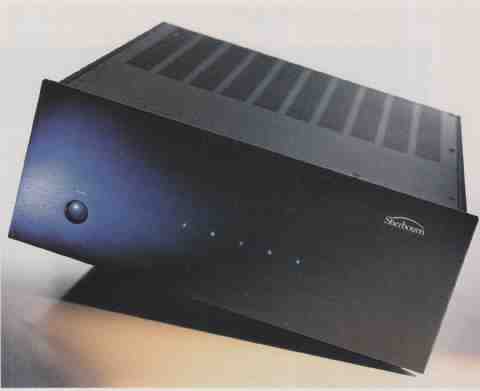
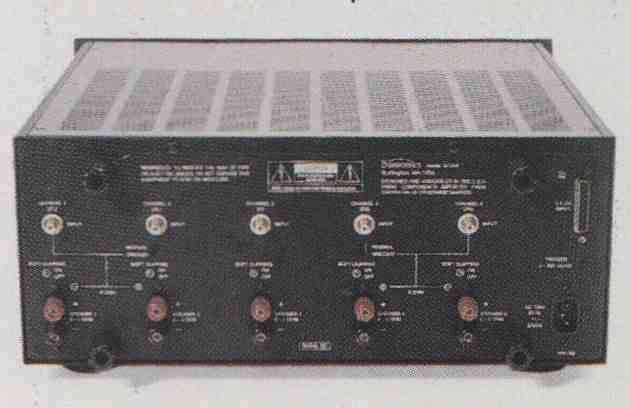
Sherbourn Technologies is a new out fit, but its principals—Ron Fone on the marketing side and Engne Tang in design—are more experienced than you’d expect in a start-up company. Fone was president of Acoustic Research (AR) during the time it was owned by Teledyne, then ran Tera (a company that made upscale TV monitors). He went on to become president of McIntosh and then of ADS. Tang was chief engineer for Proton, joined AR while Fone was president, later ran his own design and engineering company, and now has partnered with Fone to develop a line of products under the Sherbourn Technologies banner. The 5/1500, the subject of this review, is the company’s first multichannel amplifier.
Or perhaps I should have said the first four of those, because the Sherbourn is a modular power amp that is available in four configurations. You can get it as the two-channel 2/600 ($1,000), the three-channel 3/900 ($1,300), the four-channel 4/1200 ($1,600), and the five-channel 5/1500 ($1,750).
All four versions of the Sherbourn amp should perform identically, as they use identical amplifier modules for each channel. You can upgrade the lesser versions by adding modules, which Sherbourn calls “monoblocks.” Each monoblock is a single- channel amplifier with its own heat sink and power supply. The company charges $400 for a single module, $700 for a pair, and $1,000 for three. If you start with a two-channel 2/600 and expand to the full-fledged 5/1500, you’d pay only $250 more than if you had bought the five-channel model to begin with. That’s pretty economical insurance against obsolescence!
To simplify the upgrade path, the same five-channel-ready chassis is used for every Sherbourn amplifier. From the outside, a two-channel 2/600 amp looks exactly the same as a five-channel 5/1500. Each has a hefty power button on the left side of its front panel and five blue LEDs across the center. On the back are five high-quality, gold-plated RCA jacks and five pairs of gold-plated, multiway binding posts, even though not all are functional except in the 5/1500. As befits the power rating of each amp module (200 watts into 8 ohms, 300 into 4), the heavy-duty binding posts have oversized wire holes that can accommodate speaker cables as fat as 14-gauge. The posts are mounted on standard ¾-inch centers, so you can use dual or single banana plugs.
Five miniature bat-handle switches toggle soft-clipping circuits on and off for each channel. Small slide switches in the channel-2 and channel-4 chassis areas en able you to bridge channels 1 and 2 and, separately, channels 4 and 5; the amp is then rated to produce a total of 800 watts into 8 ohms or 1,200 watts into 4 ohms (not counting the fifth, unbridged, channel). In addition to the gold-plated RCA jacks for each channel, there’s a multipin DB-25 input connector on the back so that you can use a single cable for all hookups to preamp/processors having similar connections. (Sherbourn doesn’t supply a cable.)
The 16-gauge, three-wire AC cord plugs into the usual IEC connector on the back.
Four bumpers on the rear protect the wiring should you want to rest the potentially heavy chassis on its butt. (The five-channel version weighs 65 pounds.) It might be a good idea, however, to first re move the line cord.
A circuit in the 5/1500 monitors all five channels’ inputs, turning all the modules on simultaneously when any one of them is fed a signal and putting them back to sleep when all channels have been idle for a while. A low-voltage trigger input on the back panel overrides the signal-sensing circuit and turns the amplifier on when it is fed an AC or DC signal of 3 to 30 volts; this can be quite useful in custom installations.
Curiously, the front panel’s blue LEDs glow brightly when the amplifier is quiescent but dim rather than brighten as soon as any channel receives a signal. The LEDs extinguish totally when the amp is handling reasonably strong signals. According to Sherbourn, this is to prevent the LEDs’ piercing blue light from distracting viewers or listeners in a (presumably) darkened room. I’m told that the LEDs blink if the amplifier is driven into clipping, but that didn’t happen with my sample.
With the exception of the chassis, the signal-sensing board, and the AC power cord, each channel is totally independent. Each monoblock module is built in two sections: a main printed-circuit board that carries the audio amplifier and power-supply rectifiers and filters (two 10,000-microfarad capacitors) and a second section that contains a toroidal power transformer, fuse blocks, and power connectors. Each of these sections can be removed, serviced, or replaced individually.
Eight bipolar transistors are used in each amplifier’s complementary-symmetry out put stage and are said to provide a peak out put current of 30 amperes per channel. Each channel has its own heat sink, about 8 inches long and 6 inches high, sprouting twenty 2-inch tins. As the heat-radiating area is about 500 square inches per channel, Sherbourn finds no reason to use a noisy cooling fan de spite the muscular output power that the 5/1500 can deliver.
Protection circuitry monitors the operation of each amplifier and turns the affected channel off in a flash if a problem arises, so the power-supply fuses that are mounted on the transformer modules should rarely blow. The Sherbourn amp will fit into a standard rack and is four standard rack-units high (7 inches without feet). If you wish to rack-mount it, there are four screws to accommodate optional mounting ears.
Measurements
I made the bench tests while maintaining a standard 120-volt AC power supply and used 8- and 4- ohm loads. I focused my attention on channels 1 and 2 and operated them in stereo as well as bridged to mono. Except for the measurements of total harmonic distortion plus noise (THD ± N) versus power out put, which I made with and without soft clipping, all testing was done with the soft-clipping circuit switched off.
Depending on the test frequency and the load, soft clipping reduced the amp’s maximum output power by 0.5 to 1.5 dB. That’s really not much of a sacrifice in maximum power output in order to reduce hard clipping at the onset of over load. This isn’t to say that clipping distortion is eliminated by the soft- clipping circuit, just that the clipped waveform is more rounded (“soft”) than flat-topped, which suggests a lower level of high-order harmonics. (High-order harmonics are thought to be audibly more annoying than low-order harmonics.)
You can see the effect of soft clipping if you compare Fig. 1A with 1B, Fig. 2A with 2B, and Fig. 3A with 3B. Each graph shows THD ± N versus power output (in watts) at three frequencies and under different operating conditions. Figure 1 shows the curves taken with 8-ohm loads and normal (unbridged) operation. Figure 2 reveals the out put into 4-ohm loads for normal operation, while the curves in Fig. 3 were taken with the Sherbourn’s channels bridged and driving 8- ohm loads.
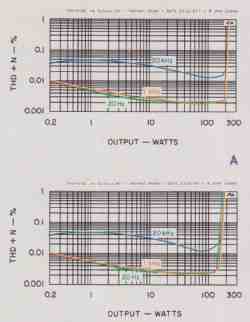
Fig. 1—THD + N vs. output B in stereo mode for 8-ohm loads, soft clipping
off (A) and on (B).
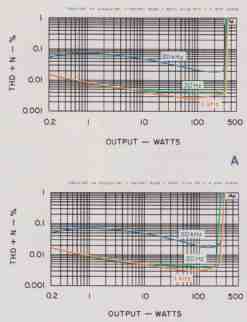
Fig. 2—THD + N vs. output B in stereo mode for 4-ohm loads, soft clipping
off (A) and on (B).
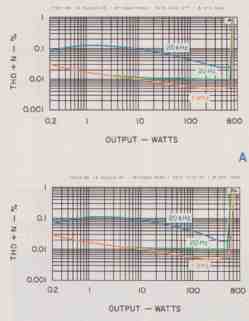
Fig. 3—THD + N vs. output in bridged mode for 8-ohm loads, soft clipping
off (A) and on (B).
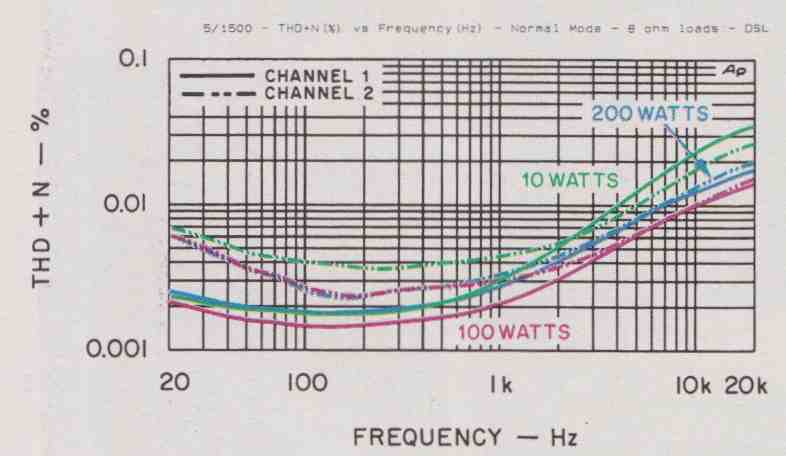
Fig. 4—THD + N vs. frequency in stereo mode for 8-ohm loads.
In each pair of graphs, the “A” set of curves was run with soft clipping off and the “B” set with it switched on. Note that different output scales are used for Figs. 1, 2, and 3. (There is no difference between the scales for the A and B figures of any of the sets.) I adjusted the scale from graph to graph so as to use the most sensitive horizontal scale for each connection and load condition. That makes it easier for you to see the difference between using soft clip ping and not using it for various load and operating conditions.
Some general conclusions can be drawn. The 5/1500’s soft-clipping circuit sacrifices more output capability in the deep bass (20 Hz) than at higher frequencies, but it has relatively little deleterious effect on distortion until you demand close-to-maximum output power from the amp. I think that’s as it should be, so I give the design of the Sherbourn amp kudos in this respect.
For Figs. 4 and 5, I tested THD + N versus frequency at output levels of 10 watts, 100 watts, and at full rated power with soft clipping off. A These curves were taken with the channels operating separately and driving 8- and 4-ohm loads, respectively; the curves in Fig. 6 show THD + N for bridged operation into an 8-ohm load. The Sherbourn 5/1500 easily met its 0.03% distortion specification (see “Measured Data”) at rated power with unbridged operation into either 8- or 4-ohm loads. The company did not provide a distortion specification for bridged operation, so I ran the curves in Fig. 6 at output levels of 10, 100, 400, and 600 watts to cover all bets. It’s apparent that in bridged operation the Sherbourn 5/1500 can deliver 600 watts into 8 ohms with less than 0.0235% distortion at any frequency from 20 Hz to 20 kHz. That’s a lot of bang.
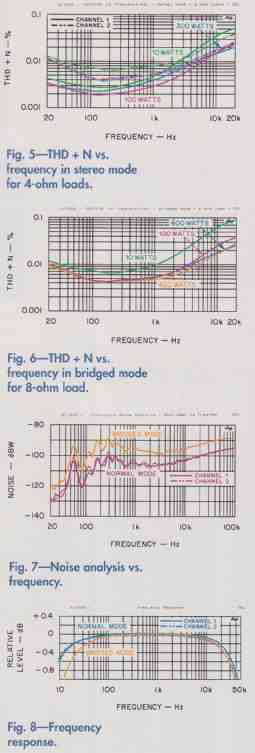
Fig. 5—THD + N vs. frequency in stereo mode for 4-ohm loads.
Fig. 6—THD + N vs. frequency in bridged mode for 8-ohm load.
Fig. 7—Noise analysis vs. frequency.
Fig. 8—Frequency response.
Prior to the onset of clipping, crossover distortion is the predominant type, which is rather problematic. Although the underlying cause of crossover distortion is quite different from what provokes clipping distortion, both types generate the same sort of high-order harmonics that Sherbourn tries to avoid with its soft-clipping circuit. As I mentioned previously, high-order harmonics tend to be more annoying than low-order harmonics; therefore, you try to avoid generating them as much as possible. Actually, crossover distortion is usually regarded as more offensive than hard clipping because clipping distortion doesn’t occur until an amplifier is overdriven, whereas crossover distortion exists at all signal levels and, as a percent age, is greater at low output levels than at high levels.
Fortunately, the absolute level of distortion in the 5/1500 is fairly low over much of the frequency range, but the crossover distortion becomes increasingly severe as the frequency approaches 20 kHz (as seen in Figs. 4, 5, and 6). Distortion measured 0.0352% with unbridged operation at 10 watts into 8 ohms and rose to 0.05 15% at 10 watts into 4 ohms (see “Measured Data”). It approached 0.1% at 20 kHz at 10 watts with bridged operation. At the 1-watt level, the distortion, expressed as a percent age, could theoretically increase by a factor of as much as three over these 10-watt readings, although my tests indicated that it rose by a factor of two or less.
With normal, unbridged, operation into 8-ohm loads, dynamic and continuous output power at clipping were virtually the same. This suggests that the output power into 8 ohms is limited by the voltage of the power supply rather than by its current capacity. With normal operation into 4 ohms and with bridged operation into 8 ohms, there was a bit more dynamic power avail able than continuous power, but the difference was still relatively small (0.5 to 0.7 dB), which implies a pretty “stiff’ power supply.
Because the supply is stiff but not regulated, maximum output power will depend on the voltage of your AC power line. This is not at all unusual, and I point it out be cause, with all channels delivering maxi mum power, the 5/1500 draws considerable current from the power line. Under this condition, the line voltage at the wall outlet in most homes will likely be well below the 120 volts I used on the test bench. This will limit the total amount of power you can get out of the amplifier (as it would with any other high-power amp).
+++++++++++++++
MEASURED DATA:
Output Power at Clipping (1% THD at 1 kHz): 8-ohm loads, 230 watts/channel (23.6 dBW); 4-ohm loads, 365 watts/channel (25.6 dBW); bridged mode, 8-ohm load, 735 watts (28.7 dBW).
Dynamic Output Power: 8-ohm loads, 240 watts/channel (23.8 dBW); 4-ohm loads, 425 watts/channel (26.3 dBW); 2-ohm loads, 660 watts/channel (28.2 dBW); bridged mode, 8-ohm load, 830 watts (29.2 dBW).
Dynamic Headroom re Rated Output: 8-ohm loads, +0.8 dB; 4-ohm loads, +1.5 dB. THD + N, 20 Hz to 20 kHz: 8-ohm loads, less than 0.0205% at rated output and less than 0.0352% at 10 watts; 4-ohm loads, less than 0.0262% at rated output and less than 0.05 15% at 10 watts; bridged mode, 8-ohm load, less than 0.026% at 400 watts, less than 0.0235% at 600 watts, and less than 0.0903% at 10 watts.
Damping Factor re 8-Ohm Loads: 64.
Output Impedance: 128 milliohms at 1 kHz, 134 milliohms at 5 khz, 143 milliohms at 10 kHz, and 144 milliohms at 20 kHz.
Frequency Response: Stereo mode, 20 Hz to 20 kHz, +0, —0.26 dB (—3 dB below 10 Hz and at 87.2 kHz); bridged mode, 20 Hz to 20 kHz, +0, —0.51 dB (—3 dB below 10 Hz and at 74.3 kHz).
Sensitivity: Stereo mode, 83.9 mV for 0-dBW (1-watt) output and 1.185 V for rated output; bridged mode, 41.3 mV for 0-dBW output.
Voltage Gain: Stereo mode, 30.6 dB; bridged mode, 36.7 dB.
A-Weighted Noise: Stereo mode, —91.7 dBW; bridged mode, —83.6 dBW.
Input Impedance: 16.3 kilohms.
Channel Separation, 100 Hz to 10 kHz: Greater than 81.2 dB. Channel Balance: ±0.02 dB.
++++++++++++++++++
Fig. 7 shows the amp s noise spectra for normal and bridged operation. In all of the curves, there’s a fair amount of power-line-related hum at 60 Hz and its odd harmonics (180, 300, and 420 Hz); however, there’s relatively little hum at the even harmonics (120 Hz, 240 Hz, etc.). The paucity of components at the even harmonics suggests excellent power-supply filtering, but the odd-harmonic con tent indicates a fair amount of magnetic leakage from the power transformers, even though they are toroidal.
As Fig. 7 indicates, the noise in bridged operation is about 8 dB higher than when the amp channels operate individually (see also “Measured Data”). Six decibels of the difference can be explained by the higher sensitivity in bridged operation; the other 2 dB are up for grabs. Overall, the noise level is reasonably low for so powerful an amplifier; nevertheless, I’d not object if it were better.
Figure 8 compares the Sherbourn 5/1500 amp’s frequency response for normal and bridged operation. As usual, these curves were run at 1-watt output into an 8-ohm load. Note the sensitive vertical scale that I used to reveal the response difference in the two modes of operation. Often there’s a substantial treble rolloff in bridged mode, but that’s not true of the Sherbourn 5/1500. There’s less than 0.1-dB difference in 20- kHz response when bridging two channels of this amp. Most of the difference comes at the low-frequency end, where the response at 20 Hz in bridged mode is down 0.51 dB but only half that much in normal operation.
Input/output phase shift was + 12.10 at 20 Hz and —15.4° at 20 kHz for unbridged operation, while in bridged mode, it was + 18.7° at 20 Hz and —19.4° at 20 kHz. Typically, you expect to find more phase shift when two channels are bridged than when they aren’t, so I don’t think these results are any cause for concern.
Channel separation was excellent, one of the strong suits of monoblock designs. Channel gains were very well balanced, which is nice to see. Input impedance was lower than specified but higher than is the case with many power amplifiers, so it’s fine with me.
One of the Sherbourn 5/1500’s best characteristics is its remarkably uniform output impedance. I’m not sure I’ve ever seen an output impedance characteristic quite this flat: 125 milliohms at 50 Hz (where damping factor is measured), rising to less than 145 milliohms at 20 kHz! Now, that doesn’t translate to the world’s highest damping factor—it’s only 64—but it doesn’t concern me one whit. A damping factor of 64 is high enough for all practical purposes. What is important is that the output impedance be uniform so it doesn’t change overall frequency response if you use speakers that have crazy impedance curves of their own. This is one amplifier that meets that criterion in spades!
Use and Listening Tests
I prefer to tread lightly rather than heavily with a preproduction sample of a brand- new amplifier from a brand-new company. And the Sherbourn 5/1500 is an amplifier with a lot of potential. My major beef with it (in its present incarnation) is that it sounded a bit confused in the high end, which became fatiguing after a while. I noticed this more in my music-listening room than in my home theater, but I listen more carefully to music than I do to videos, so I’m not surprised at that. Frankly, I think a slight adjustment in operating bias might do a world of good for this amp and let it capitalize on its strengths—for example, its marvelously uniform output impedance, which bodes extremely well for getting smooth frequency response from hard-to-drive loudspeakers.
I didn’t hear any audible effects from the soft-clipping circuit, which is as it should be. Even when it’s on, soft clipping should do nothing until you’re about to clip the amp, and that’s not likely to happen often when you have this much power per channel at your command. But I don’t think I got close to clipping the 5/1500 in the listening room. This amp has lots of drive capability, and the louder I played it, the better it sounded.
Whether or not you ever use the soft- clipping circuit or bridge the amplifier, having these features available is better than not having them. And that underscores the real strengths of this component and the essence of this review: The Sherbourn 5/1500 is a value-packed amplifier! Lots of watts for the buck, great flexibility, easy upgradability, what seem to be top-quality parts (I love the input RCAs and the heavy duty output posts), and a five-year warranty. In any of its guises, the 5/1500 is a promising launch vehicle for Sherbourn Technologies.
Adapted from 1998 Audio magazine article. Classic Audio and Audio Engineering magazine issues are available for free download at the Internet Archive (archive.org, aka The Wayback Machine)